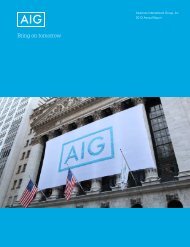2007 Annual Report - AIG.com
2007 Annual Report - AIG.com
2007 Annual Report - AIG.com
Create successful ePaper yourself
Turn your PDF publications into a flip-book with our unique Google optimized e-Paper software.
American International Group, Inc. and Subsidiaries<br />
( The Liquidity Risk Committee is responsible for liquidity in some cases, insuring, causing the value of the assets to<br />
policy and implementation at <strong>AIG</strong> Parent and exercises decline or insured risks to rise; and (ii) as cross-border risk where<br />
oversight and control of liquidity policies at each <strong>AIG</strong> entity. a country (sovereign government risk) or one or more non-<br />
See Capital Resources and Liquidity herein.<br />
sovereign obligors within a country are unable to repay an<br />
( The CRC is responsible for the following: obligation or are unable to provide foreign exchange to service a<br />
( approving credit risk policies and procedures for use credit or equity exposure incurred by another <strong>AIG</strong> business unit<br />
throughout <strong>AIG</strong>;<br />
located outside that country.<br />
( delegating credit authority to business unit credit officers <strong>AIG</strong>’s credit risks are managed at the corporate level by the<br />
and select business unit managers;<br />
Credit Risk Management department (CRM) whose primary role is<br />
( approving transaction requests and limits for corporate, to support and supplement the work of the CRC. CRM is headed<br />
sovereign and cross-border credit exposures that exceed the by <strong>AIG</strong>’s Chief Credit Officer (CCO), who reports to <strong>AIG</strong>’s CRO.<br />
delegated authorities;<br />
<strong>AIG</strong>’s CCO is primarily responsible for the development and<br />
( establishing and maintaining <strong>AIG</strong>’s risk rating process for maintenance of credit risk policies and procedures approved by<br />
corporate, financial and sovereign obligors; and<br />
the CRC. In discharging this function CRM has the following<br />
( conducting regular reviews of credit risk exposures in the responsibilities:<br />
portfolios of all credit-incurring business units. ( Manage the approval process for all requests for credit limits,<br />
( The Derivatives Committee (DC) reviews any proposed deriva- program limits and transactions.<br />
tive transaction or program not otherwise managed by <strong>AIG</strong>FP. ( Approve delegated credit authorities to CRM credit executives<br />
The DC examines, among other things, the nature and purpose and business unit credit officers.<br />
of the derivative transaction, its potential credit exposure, if ( Aggregate globally all credit exposure data by counterparty,<br />
any, and the estimated benefits.<br />
country and industry and report risk concentrations regularly to<br />
( The CSFTC has the authority and responsibility to review and the CRC and the Finance Committee of the Board of Directors.<br />
approve any proposed CSFT. A CSFT is any transaction or ( Administer regular in-depth portfolio credit reviews of all<br />
product that may involve a heightened legal, regulatory,<br />
investment, derivative and credit-incurring business units and<br />
accounting or reputational risk that is developed, marketed or re<strong>com</strong>mend any corrective actions where required.<br />
proposed by <strong>AIG</strong> or a third party. The CSFTC provides guidance ( Develop methodologies for quantification and assessment of<br />
to and monitors the activities of transaction review <strong>com</strong>mittees credit risks, including the establishment and maintenance of<br />
(TRCs) which have been established in all major business<br />
<strong>AIG</strong>’s internal risk rating process.<br />
units. TRCs have the responsibility to identify, review and refer ( Approve appropriate credit reserves and methodologies at the<br />
CSFTs to the CSFTC.<br />
business unit and enterprise levels.<br />
<strong>AIG</strong> closely monitors and controls its <strong>com</strong>pany-wide credit risk<br />
Credit Risk Management<br />
concentrations and attempts to avoid unwanted or excessive risk<br />
accumulations, whether funded or unfunded. To minimize the level<br />
<strong>AIG</strong> devotes considerable resources, expertise and controls to<br />
of credit risk in certain circumstances, <strong>AIG</strong> may require third-party<br />
managing its direct and indirect credit exposures, such as<br />
guarantees, collateral, such as letters of credit or trust account<br />
investments, deposits, loans, reinsurance recoverables and<br />
deposits or reinsurance. These guarantees, letters of credit and<br />
leases, as well as counterparty risk in derivatives activities,<br />
reinsurance recoverables are also treated as credit exposure and<br />
cessions of insurance risk to reinsurers and customers and credit<br />
are added to <strong>AIG</strong>’s risk concentration exposure data.<br />
risk assumed through credit derivatives written and financial<br />
<strong>AIG</strong> defines its aggregate credit exposures to a counterparty as<br />
guarantees. Credit risk is defined as the risk that <strong>AIG</strong>’s customers<br />
the sum of its fixed maturities, loans, finance leases, derivatives<br />
or counterparties are unable or unwilling to repay their contractual<br />
(mark to market), deposits (in the case of financial institutions)<br />
obligations when they be<strong>com</strong>e due. Credit risk may also be<br />
and the specified credit equivalent exposure to certain insurance<br />
manifested: (i) through the downgrading of credit ratings of<br />
products which embody credit risk.<br />
counterparties whose credit instruments <strong>AIG</strong> may be holding, or,<br />
<strong>AIG</strong> <strong>2007</strong> Form 10-K 113

















